

| This is a special section that I have put together about the "Perfect" storm in late October of 1991. This is due to the popularity and awareness of this event aroused by the bestseller novel and movie (Warner Brothers) entitled "The Perfect Storm". I have included this event into my STORM CHASING section because I have done observations of the tremendous waves from this storm, way down here in South Florida. I have put together some pictures of the damage the waves from this storm, which were up to 30 feet near West Palm Beach, Florida. |
The "Perfect" storm itself was over a thousand miles away from the coast of Florida and was to the east of Gloucester, Massachusettes and New England, however, the SWELL WAVES radiated out of the storm like ripples from a pebble being thrown into a pond. They reached Florida on October 31, 1991, Halloween. The eastward jut of the Florida East coast, the Gulf Stream current, and undersea countours caused a "focus" in the incoming long-period NORTH SWELL in Palm Beach, Florida. At high tide, the sea surged over seawalls, smashed piers, flooded road A1A, and literally sent rocks flying through the air. The waves nearly KILLED me as I was observing them and I was swept off the seawall. An up-close and personal touch with the power of the "Perfect" storm, however much less tragic than the fate of the crew aboard the Andrea Gail fishing vessel, over a thousand miles to MY northeast. The "Perfect" storm was an EXTRATROPICAL storm that entrained the moisture and energy of hurricane Grace. A POLAR VORTEX and jet stream disturbance allowed the extratropical low to intensify to a massive low pressure system with winds over 75 MPH. The storm backed up to the southwest, instead of the northeast, because it was cut-off from the main westerly winds aloft. As the storm moved south, it interacted with the warm ocean and developed another mini-hurricane right in its center, becoming a HYBRID or SUBTROPICAL storm, having the conditions of both a hurricane and an extratropical storm! This rare and unprecidented storm affected a tremendous area of the North Atlantic Ocean and went down in history as the "Perfect" storm of 1991!
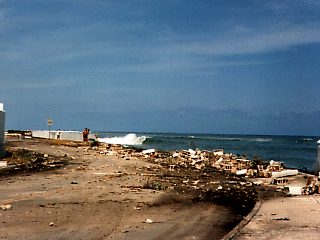
|
This picture was taken in West Palm Beach, Florida on November 1, 1991. Tremendous swell waves, as high as 30 feet, smashed into the area a day earlier. Sections of seawalls and piers were demolished by the brute force of the long-period swell and tidal surges. The road is A1A and is closed due to the destruction of the sea wall and debris covering the roadway. These swells were from an unsually intense ocean storm off New England - the "perfect" storm ... Over 1200 miles to the Northeast. |
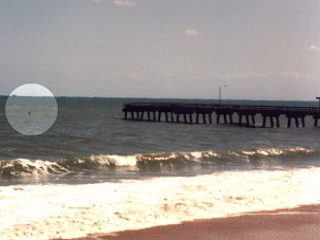
|
About 200 feet of the Lake Worth municipal fishing pier was destroyed by the 20 foot plus breakers on October 31, 1991 in Lake Worth, Florida. The circled area is a single piling which marks where the end of the pier once stood. Damage was over $250,000 dollars and occurred in only seconds from two breaking swells which turned the entire ocean "white to the horizon". Seas are much calmer a day later when this picture was taken. A NOAA weather station, once at the end of the pier, was also lost. |
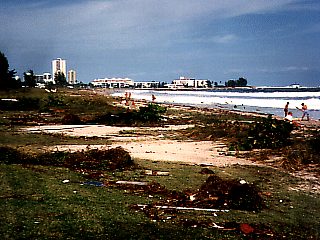
|
A view looking north at Singer Island and Lake Worth Inlet in West Palm Beach, Florida on November 1, 1991. Debris and sand marks how high the surging waters came up a day earlier at high tide. Note the debris line in the foreground and nearly all of the beach eroded away. |
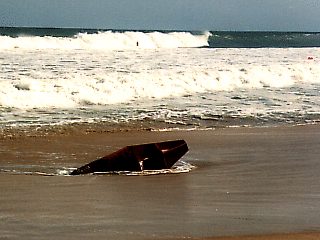
|
A channel marker, from Lake Worth Inlet, washes ashore near Reef Road in West Palm Beach, Florida. This picture was taken on November 1, 1991. This buoy was once anchored hard off the inlet but had no resistance against the force of the breaking swells and wound up buried in the sand. Other channel markers were also moved or torn loose. Note the surfer in the center of the picture who is about six feet high ... Note the size of the wave behind him! The waves here were much smaller than the day before. |
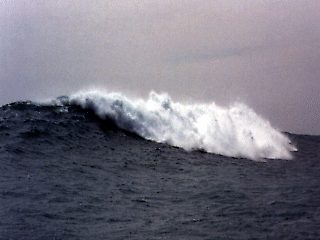
|
A more forgiving swell wave breaks several hundred yards off Lake Worth Inlet in West Palm Beach, Florida on November 1, 1991. The wave here is breaking on an offshore bank and is about 15 feet high but does not have the destructive properties as the waves a day earlier. A modified Sea Doo watercraft was used to get into position to view and photograph these waves. The wave here, after breaking, reached speeds of about 30 MPH. |
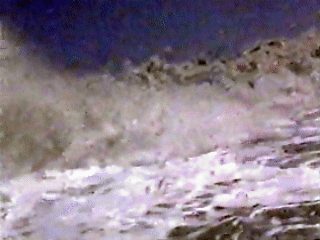
|
This picture was taken about a mile off Lake Worth Inlet in West Palm Beach, Florida on October 31, 1991. The wave here is breaking at over 20 feet high well past the inner channel marker on the outside bank of the inlet. The picture was taken from a video camera in a water-proof case while riding ahead of the deadly wave on a modified Sea Doo watercraft. The breaking was was keeping up with me at 45 MPH! Note the appearance of the breaking wave, I am looking UP at it ... I described it as "dirty boiling milk". These waves can exert forces over 5,000 LBS per square foot and caused severe damage (even after rolling into the beach and losing 90 percent of their energy). |
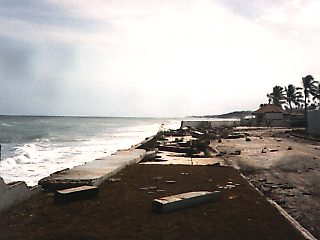
|
Debris and sand lies strewn across A1A in West Palm Beach, Florida on November 1, 1991. The swells destroyed the seawall and threw out concrete slabs into the road. You were actually able to see fish floating down the road during the high tides! A1A is obviously closed in this picture. |
HTML File "perfstrm.htm" - Developed By Chris Collura
To Return To The HOME Page Of This Site Click The "INDEX.HTM" Link Here!